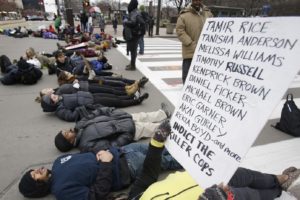At a time when the fatal shooting of unarmed Black men has placed police patterns and practices under the microscope, a handful of police departments are employing a new tactic — awarding officers for showing restraint on the job.
As the Associated Press reported, the LAPD has created a Preservation of Life Award. Since December, over 40 Philadelphia cops have been awarded for neutralizing conflicts without resorting to beating, shooting or using excessive force against civilians. And the U.S. Department of Justice has instituted Community Policing Awards to recognize police who de-escalate potentially disastrous situations.
In light of the death of Michael Brown in Ferguson, Freddie Gray in Baltimore, Eric Garner in New York City, Walter Scott in North Charleston, and so many others, greater attention is now being paid to police use of excessive force and ways to defuse tense encounters between law enforcement and members of the community.
“An officer going home is of paramount importance to us, but everybody should have an opportunity to go home if that presents itself,” Philadelphia Police Commissioner Richard Ross told AP. “This is an effort to slow down situations for the sake of everybody concerned.”
“It says that force should be a last resort and that we value this,” added Ronald Davis, director of the Justice Department’s Office of Community Oriented Policing Services, who said more police agencies should consider such awards.
While supporters of the measure believe it is necessary to build trust in the community and help deal with suspects with mental illness or drug dependency, skeptics — particularly in the law enforcement community — are against such awards because they believe they will cause officers to second-guess themselves, and hesitate in situations when their life is in danger. Especially in cases in which white murder suspects — even mass murder suspects such as Dylann Roof — are taken into custody, there is ample evidence that police have the will and capability to show restraint and put down their weapons.
Although the policy has the potential to save lives, there is still the problem of implicit bias in policing and the criminal justice system. Studies have shown that police exhibit shooter bias against Black people. Officers are more likely to shoot Black people to death, even as Black people are less likely than whites to attack officers. Researchers at the University of Louisville and the University of South Carolina found that Blacks are seven times more likely to die from a police officer’s gun. Further, the primary factor in determining whether the victim was unarmed was whether that person is Black. Moreover, studies suggest that the nation’s predominantly white male police force has its collective head in the sand on issues of racism, believing in the concept of colorblindness and the notion that racism is no longer present in society.
These efforts come as other jurisdictions seem to move in the opposite direction and increase the level of mistrust between the police and the general public.
For example, last week Louisiana Gov. Bel Edwards signed the “Blue Lives Matter” bill into law, making Louisiana the first state to consider police and other public safety personnel a protected class under hate crime statutes. As The Washington Post reported, the new law covers additional penalties for those who target police officers, firefighters and emergency medical service workers. Such legislation is viewed as a direct police response against the Black Lives Matter movement and its call for greater scrutiny of police killings, and the false notion that there is a war on police, particularly by Black activists. This comes at a time when there is a dramatic overall decline in the number of assaults and murders of police, with 2013 being the safest year for police on record, according to NPR.



